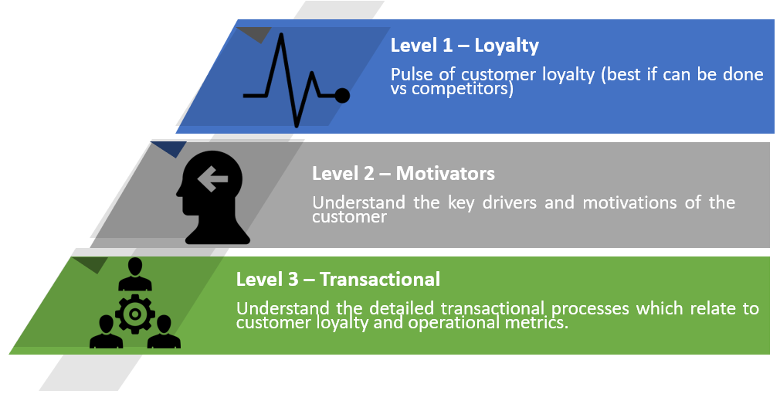
Startup leaders often ask, “is my company big enough to worry about measuring customer experience?” I most often respond with a few questions of my own. Do you care about retention? Do you care about revenue? If the answer to either of these questions is yes, then you are big enough to worry about measuring customer experience.
Like everything else in your company, customer experience metrics should be built to scale. Startups can start small and simple, but it is important to start right.
At Fractal River we look at Customer Experience in three levels:

Level 1 provides a pulse of the customer’s opinion of your company. It isn’t based on any specific event; it is intended to capture the general sentiment of the customer. Usually in Level 1, companies focus on loyalty, but sometimes satisfaction is included as well. Customers shouldn’t receive this type of survey more than every quarter, with most companies choosing a biannual cadence. A Level 1 survey can be amplified to include a competitor viewpoint. Rather than surveying customers only about your company, they are surveyed about your company and your competitors to better understand relative sentiment.
Level 2 enables companies to specifically understand what their customers like/dislike and what is important to them. Understanding the drivers behind the customers opinions provides insights on where to focus. Customers may dislike your customer support, but at the same time they might think customer support is not very important. By knowing both what is important and what is/is not performing, the company can focus their resources on areas of importance that are underperforming.
Level 3 provides more tactical information. By measuring the health of specific customer touchpoints, your company can get constant immediate feedback from your customers. This provides an opportunity to directly follow-up when the customer is dissatisfied, as well as an ongoing sense of the health of your process. Timeliness is the key to distributing these surveys. By sending them immediately following the touchpoint, customers will have the best recollection of the specific experience.
Level 1 (Loyalty) and Level 3 (Transactional) are both excellent places to start measuring customer experience. Level 1 is accessible by any company. It doesn’t require any substantive processes or tools to be in place throughout the customer journey. And the value of understanding the customer sentiment may be extremely helpful to startups to determine if revenue or retention are at risk. Level 3 is great for companies who have a particular process in place – a support process or an onboarding process for example. The benefit of having that constant stream of data is useful in mitigating small problems from turning into revenue or retention risks. In addition, the consistency of receiving data on a daily/weekly/monthly basis means trends can be identified more quickly. Typically, Level 2 surveys are implemented last – as they provide additional insights into the data already acquired in Level 1 and 3.
Now it’s time to start implementing. For Level 3, if you have already implemented an issue management system (Zendesk, Hubspot Service, Salesforce Service, Intercom, etc.) many of them come with built in surveying capabilities. Use the out-of-the-box questions (like “How would you rate the support you received?”) to see how you are doing – it’s a great place to start.
Maybe your company has a somewhat lengthy onboarding process. Use the completion of that process to jump start your Level 3 surveying by asking them how satisfied they are with the implementation process? You can use basic survey functionality from providers like SurveyMonkey or Typeform that are easy to use and have packages that scale as you need more functionality.
If transactional surveying seems elusive because you don’t have the people, processes, or tools in place yet, it’s equally appropriate to start with Level 1 (Loyalty).
At Fractal River we recommend measuring three aspects of loyalty: advocacy, retention, and purchase. These elements of loyalty are represented by three survey questions:

We highly recommend using an 11-point Likert scale for each of these questions (i.e., asking customers to rate you on a scale from 0 to 10). With this method you will have consistency across the results, and you will be positioned for calculating five different metrics.
These metrics Advocacy, Retention, Purchase, and an aggregate metric of the three, Customer Loyalty Index (CLI), can be calculated for each customer. And with the advocacy question you can also calculate the company Net Promoter Score (NPS).

Three little questions, and you will have data to drive account actions and measure the health of your installed base. If you are feeling bold, add an open-ended question to the survey as well. Consider two types of free-response questions: driver and improvement. Adding a driver question like “What is the main reason for the score you provided?” allows the customer to express the why behind their response. By understanding the drivers, you can start to better influence the outcome. An improvement question like “Please tell us the one thing you would like to see changed about us.” will provide focus on improvement areas for the company. You are starting to dabble in that Level 2 space without dedicating a whole survey to the process.
Once you choose to survey, it is critical that you actively use this data to improve your company. Make the information visible. Post results to your #customerfeedback slack channel. Talk about customer responses and your action plans at all-hands, team meetings and company strategy sessions. The way your team knows that the customer experience is important is by talking about it. If employees believe and act like customer experience is important, customers will feel it.
Beyond your employees, talk to your customers about the feedback that you’ve received and the actions that you are taking as a result of their feedback. Customers will not only have a more favorable opinion of your company, but we have also seen dramatic improvements in survey response rates when customers know their feedback is making a difference.
It is never too early to start measuring your customer experience. Start with a simple transaction or loyalty survey, use the information to improve your people and processes, and then evolve your surveys and metrics over time as your company scales.
At Fractal River, we help startups build and scale their customer journey from sales, onboarding, service delivery and customer success. If you or one of the companies in your portfolio are ready to drive your customer experience forward, we’d love to hear from you!
Recent posts



